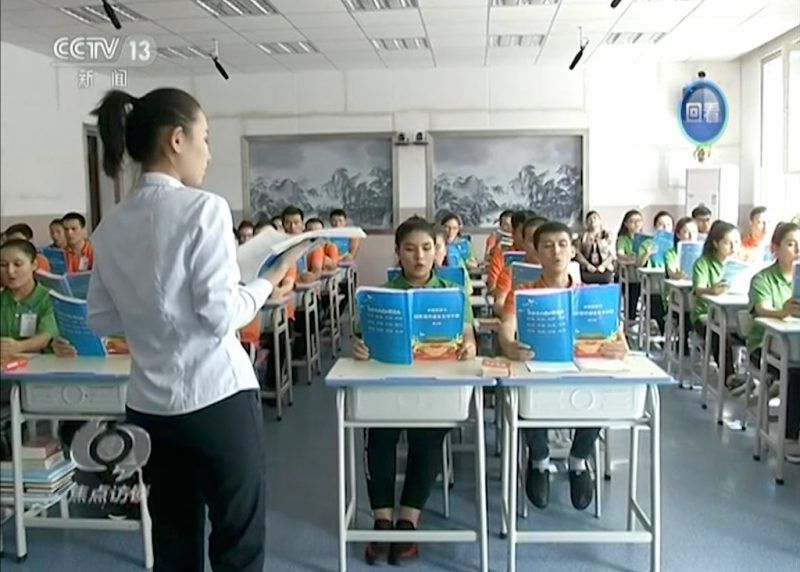
“Citizens, please remain calm and relax, no one in the re-education camps will starve, be left in the cold, be punished or be forced to work.” With these words, an official from China’s Communist Youth League tried to reassure relatives and friends of members of predominantly Muslim ethnic minorities who had been taken to internment centers. The detainees were “infected by an ideological illness,” the official said, and the camps would “cleanse the virus from their brain.”
When the speech was delivered in October 2017, the camps were unknown even to some of the people they targeted, the roughly 11 million ethnic Uighurs and one million Kazakhs of Xinjiang, a nominally autonomous region in northwestern China. A year later, the network of indoctrination centers is widely known even outside China: first revealed by inmates’ families and then confirmed, perhaps unwittingly, by the government’s public call for bids on procurement contracts to build camp infrastructure — and now by an official justification of sorts.
A couple of weeks ago, the Xinjiang People’s Congress passed legislation that for the first time provides an explicit basis for the “transformation” of people influenced by “extremism” in “education institutions” through “ideological education, psychological counseling, behavioral correction, Chinese language training” and other programs. Last week, the chairman of Xinjiang’s government described the camps as air-conditioned boarding schools that offer cultural programs for people suspected of minor offenses to help them realize that “life can be so colorful.”
Yet former participants have described a system of forced detention and abuse, with military-style discipline, solitary confinement, beatings and in some cases torture.
In the past, local officials and local media would sometimes boast online of successfully implementing this camp system. But more senior officials — presumably partly out of concern with global opinion — have tended to profess ignorance, including as late as August, in response to questions by a United Nations panel on racial discrimination.
So why is China suddenly acknowledging a network of internment centers whose existence it had so adamantly denied?
Some news reports say that the law “legalizes” the camp system. But that characterization is misleading: Authorizing the construction and administration of so-called training centers does not in itself sanction the extrajudicial internment of people in them, which, as some scholars have argued, is illegal even under Chinese law.
The recent legislation does, however, recognize and officialize the detention system — and that’s significant.
In China, the law sometimes seems to play catch-up with enterprising officials. For example, “abnormal” beards were legally banned in March 2017, years after the Xinjiang authorities had begun arresting or otherwise penalizing men with large beards. Likewise, the latest legislation is evidence that the entire camp program has evolved from local, extralegal improvisation to a formal system that is to be woven into the fabric of the Chinese state.
The internment camps no longer are an ad hoc measure; they are meant to be permanent. And their reach is spreading geographically.
Uighurs throughout China have been called back to Xinjiang by their hometown police and then detained. Thousands of Uighurs also appear to have been sent out of Xinjiang to prisons elsewhere in China.
The central government in Beijing provides part of the funding for this enormous internment and indoctrination system. And only the highest levels of the ruling Politburo could have decided in 2016 to reassign Tibet’s party chief Chen Quanguo to Xinjiang — to which he brought some of the repressive measures he had used against Tibetans and Buddhist pilgrims.
The intensifying repression against Uighurs and other minorities in Xinjiang reflects a nationwide shift in the government’s approach to ethnic difference. Whereas the Chinese Communist Party (C.C.P.) once professed to value diversity, it now increasingly seeks to assimilate minorities: In recent years, it has even encouraged Uighurs to marry members of the ethnic Han majority by offering cash to mixed couples. And as the anthropologist Darren Byler has documented, the authorities are enlisting Han civilians in their efforts, sending them out as “big brothers” and “big sisters” to check in on and watch Uighur and Kazakh homes.
The foremost theorist of this Sinicization project, known as “ethnic mingling,” is Hu Lianhe, an official at the Central Political and Legal Affairs Committee. He was the Chinese representative who denied the existence of re-education camps in Xinjiang to the United Nations panel this summer. Mr. Hu is also known for developing a “theory of stability” that links ethnic identity with extremism, and as the political scientist James Leibold recently pointed out, Mr. Hu’s growing visibility likely is no coincidence. It may portend a far more comprehensive effort by the government in Beijing to control and subjugate non-Han minorities throughout the country within what official propaganda calls the “Chinese race.”
As the C.C.P. has steadily moved away from recognizably communist policies over the last three decades, its leaders have increasingly justified their rule through Han-centered nationalism and by casting the party as the ultimate guarantor of China’s stability and prosperity, notions encapsulated under the slogan “Chinese Dream.” Uighur aspirations for basic cultural rights and more autonomy threaten those claims, and the handful of Uighur terrorist attacks over the past decade or so call into question the C.C.P.’s ability to protect the country’s ethnic-Han majority.
Han-centric racism and Islamophobia may be driving China’s leaders to blame unrest on Uighur culture and religion. But behind their efforts to forcibly re-engineer minority cultures also lies a pressing need to boost their legitimacy and account for their hold on power. The Xinjiang problem, in their view, isn’t a local issue; it’s a threat to the foundations of the entire system they oversee today.
Rian Thum is a senior research fellow at the University of Nottingham and the author of The Sacred Routes of Uyghur History.
